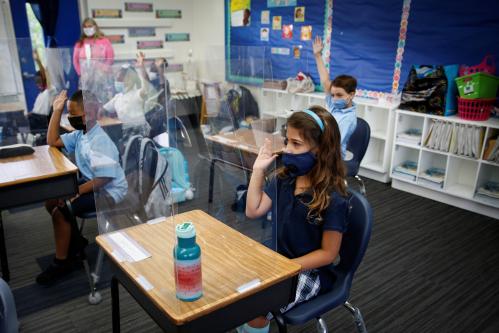In the space of just over a decade, the federal government has twice provided emergency fiscal stimulus to the public K-12 education system at a cost of nearly a quarter of a trillion dollars. First, in the wake of the Great Recession, the American Recovery and Reinvestment Act (ARRA) of 2009 distributed nearly $50 billion to schools via State Fiscal Stabilization (SFSF) funds. Second, in response to the COVID-19 pandemic, $190 billion has been provided to schools via three legislative acts collectively referred to as Elementary and Secondary Schooling Emergency Relief (ESSER) funds.
ARRA and ESSER aimed to address different educational problems. ARRA was passed in the first year of the Great Recession and allocated nearly $50 billion to states to try and restore K-12 funding to pre-recession levels. With ESSER, state budgets were much less affected by COVID-19 than anticipated, with initial estimates projected to be upward of $650 billion but revised down to about $22 billion. However, the effect of the pandemic on learning outcomes, as measured by test score performance, has been enormous. As a result, ESSER stipulates that a portion of funds must be used to offset learning loss.
In a new paper, we draw parallels between these two historically unprecedented federal interventions into the public education sector. Our analysis focuses on three questions:
- Were federal funds sufficient to meet policy goals?
- Were funds allocated to districts with the greatest need, as defined by policy goals?
- Were funds used to accomplish purported policy goals?
Were federal funds sufficient to meet policy goals?
Though the Great Recession technically started in 2007 and ended in 2009, its impact on K-12 finances persisted through the 2013-14 academic year. During this span, K-12 expenditures declined by approximately $223 billion—even accounting for ARRA—translating to a decline of approximately $945 per pupil per year. ARRA aid was mostly sufficient for the first three years of the Great Recession, offsetting nearly 100% of district expenditure losses in the 2008-09 and 2009-10 school years and about 40% of losses in the 2010-11 school year. However, K-12 expenditures continued to decline while ARRA aid was mostly exhausted. From 2011-12 to 2013-14, K-12 expenditures declined by about $1,400 per pupil per year, whereas remaining ARRA funds were limited to $50 per pupil per year. These persistent spending declines during the Great Recession had predictably deleterious effects on student achievement.
For ESSER, our sense is that policymakers have not fully reckoned with the magnitude of learning loss that has taken place during the pandemic and the costs necessary to offset this loss. In contrast to other work on this topic, we do not determine per-pupil costs based on an à la carte menu of services a school district can purchase; instead, we estimate how much money would be needed to completely offset the cumulative learning loss resulting from the pandemic. To arrive at such an estimate, we need: (i) the total decline in student achievement that accrued during the COVID-19 pandemic and (ii) the marginal cost of increasing student achievement.
Estimates of learning loss vary widely. At the high end, an impact evaluation from the Netherlands found that a year of remote instruction would have reduced achievement for low-income and non-low-income students by 0.48 SD and 0.35 SD, respectively. Other estimates based on current test-takers find that achievement for low-income and non-low-income students declined by 0.25 SD and 0.21 SD, respectively.
A recent meta-analysis of the causal impacts of school spending on student achievement provide us with the second piece of information. The authors find that a $1,000 increase in per-pupil spending per year increases achievement for low-income and non-low-income students by 0.012 SD and 0.007 SD, respectively.
To put these estimates in perspective, there are about 11 million children in the U.S. in poverty. If these children lost 0.48 SD of achievement on average—and if we believe that each $1,000 in additional per-pupil spending would bring about 0.012 SD in academic gains in our current context (a notable assumption, though whether these funds would be more or less effective at offsetting COVID-19-induced learning loss is not clear)—then it would cost $40,000 per child to recover lost achievement, or $440 billion in total. This value dwarfs total ESSER funds and does not include the 38.4 million children not in poverty who, according to plausible estimates, lost between 0.21 and 0.35 SD of achievement.
Our paper describes how this estimate might look under various assumptions, but the main point is that only under some very conservative assumptions is the $189 billion in ESSER funds sufficient to offset the decline in student learning that we are currently observing.
Were federal funds allocated to those with the greatest need?
Even with sufficient funding, it is important that federal relief aid be allocated to students who need it. An underappreciated feature of both ARRA and ESSER is that the policies were allocated to states and, ultimately, school districts based on funding rules that predated the fiscal crises at hand. Consequently, federal funds were not well-aligned with policy goals and provided different levels of aid to districts with comparable levels of economic disadvantage.
In the case of ARRA, federal funds were distributed to states based largely on K-12 enrollment, while states distributed ARRA funds to districts based on pre-recession state contributions. Consequently, we have shown in prior work that ARRA aid was not distributed to districts with the greatest expenditure declines; indeed, ARRA aid was mostly uncorrelated with district-specific losses, both at the national level and for individual states. Further, because states tend to spend more money in districts with greater economic disadvantage, ARRA aid tended to be allocated to districts with more poverty. At the same time, however, states vary in how progressive they are and, consequently, districts with comparable levels of economic disadvantage received very different amounts of ARRA aid. As shown in the left panel of Figure 1 below, in some states, low-income districts received $200 in ARRA aid per pupil per year; in other states, equivalently poor districts received up to $500 in ARRA aid per pupil per year.
Figure 1: Predicted ARRA and Title I aid per pupil at the 90th percentile of poverty
Notes: Predicted ARRA expenditures and Title I revenues per pupil at the 90th percentile of economic disadvantage. Expenditure and revenues data are from the NCES F-33 fiscal file, using observed average ARRA expenditures for years 2008-09—2013-14 and observed Title I revenues for 2017-18, the most recent year available. For ARRA, economic disadvantage is measured using free or reduced-price lunch share, the measure most used by states to allocate categorical aid. For Title I, economic disadvantage is measured using district poverty from the Small Area Income and Poverty Estimate, the measure used by the federal government to determine eligibility. Predicted amounts are derived from random coefficients models, which allow intercepts and slopes to vary among states. The 90th percentile of economic disadvantage is based on national data.
For ESSER, the story is similar, but the reasons are different. ESSER was distributed via Title I allocation rules, which are based on district poverty but also other state-level features, such as average state spending per pupil. As with ARRA, this decision means that districts with greater learning loss will not necessarily receive proportionate federal aid, and districts with equivalent levels of economic disadvantage will receive different amounts of aid. To see this, first note that most current research suggests that both low-income and non-low-income students experienced substantial learning loss during the pandemic. Thus, districts that do not have concentrated poverty but nevertheless experienced learning loss will not receive sufficient aid. Second, Title I aid is distributed unevenly across states even for districts with similar levels of poverty, a feature of Title I that has received criticism recently. We illustrate this between-state inequality in the right panel of Figure 1, which shows how much Title I aid equivalently poor districts receive across states. In some states, low-income districts receive $400 per pupil in Title I; in other states, equivalently low-income districts receive $800 per pupil in Title I.
Were funds used to accomplish purported policy goals?
For this question we have the least data, which is a policy problem that we hope to draw attention to. With ESSER, there is now the danger that we will repeat some of the mistakes made under ARRA. In 2014, the Education Department’s Office of Inspector General completed a retrospective analysis of ARRA and concluded that the department needed to improve transparency, accountability, and data quality. Now, with anecdotal reports that ESSER funds are being spent frivolously, we again face concerns related to transparency, accountability, and data quality.
We recognize that accountability systems are difficult to implement, especially if the requirement is that all recipients of ESSER funds closely document how those funds are spent (a lesson recently learned from ESSA requirements for school-level financial reporting, which have generated significant burden for districts and been difficult to harmonize across states). As an alternative, consider the National Assessment for Education Progress (the NAEP), which takes a system monitoring approach to measuring educational progress by sampling students across the U.S. with the purpose of documenting broad trends in student achievement among states, between student subgroups, and over time. Such a sampling approach could be developed and implemented by the National Center for Education Statistics to provide rich snapshots of how ESSER funds are being spent. A sample of school-level spending would not allow stakeholders to identify which specific schools used ESSER funds in particular ways, but it would greatly improve upon the collection of anecdotes currently distributed by the media.
The stakes are high. The federal government has provided an essential safety net for K-12 public schools during these two educational crises. Because future crises are likely, it is imperative that policy and accountability structures are developed to document how fiscal stimulus is spent so that the public can trust that these emergency relief funds should continue to be made available.








Commentary
Has federal crisis spending for K-12 schools served its intended objectives?
Lessons from the Great Recession and COVID-19
April 12, 2022